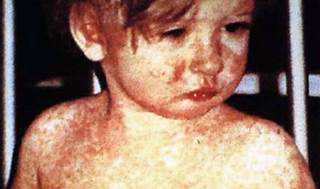Which of the following are symptoms commonly seen during the prodrome stage of measles?
Maculopapular rash.
Conjunctivitis.
Koplik spots on the buccal mucosa.
Cough and coryza.
Hyperpigmentation of the skin.
Correct Answer : B,C,D
Choice A rationale:
Maculopapular rash is a characteristic symptom of the rash stage, not the prodrome stage of measles.
Choice B rationale:
Conjunctivitis can be seen during the prodrome stage of measles, where the eyes become red, watery, and sensitive to light.
Choice C rationale:
Koplik spots are small, white spots with a bluish-white center and a red halo that appear on the buccal mucosa, and they are classic signs seen during the prodrome stage of measles.
Choice D rationale:
Cough and coryza, which include symptoms like a runny nose and cough, are commonly observed during the prodrome stage of measles.
Choice E rationale:
Hyperpigmentation of the skin is not a symptom typically associated with the prodrome stage of measles.
Nursing Test Bank
Naxlex Comprehensive Predictor Exams
Related Questions
Correct Answer is D
Explanation

The correct answer is choice d. Airborne precautions.
Choice A rationale:
Standard precautions are the basic level of infection control that should be used in the care of all patients all of the time. These precautions are designed to reduce the risk of transmission of microorganisms from both recognized and unrecognized sources. However, they are not sufficient to prevent the transmission of measles, which is an airborne virus.
Choice B rationale:
Droplet precautions are used for diseases that are transmitted by large droplets that are expelled into the air and travel 3 to 6 feet from the patient. Measles is not primarily transmitted by large droplets and therefore, droplet precautions are not the most effective measure for preventing measles transmission.
Choice C rationale:
Contact precautions are used for infections, diseases, or germs that are spread by touching the patient or items in the patient’s room. Measles is highly contagious and can be spread through the air by breathing, coughing, or sneezing, so contact precautions alone would not prevent the spread of measles.
Choice D rationale:
Airborne precautions are required for diseases that are transmitted by smaller droplets, which remain in the air for long periods of time and can be spread over long distances when the infected person breathes, coughs, or sneezes. Measles is known to be highly contagious and can remain airborne for up to two hours in an airspace after the infected person leaves an area. Therefore, airborne precautions, which include the use of a high-efficiency particulate air (HEPA) filter and special respiratory protection, are necessary to prevent the spread of measles.
Correct Answer is C
Explanation
Choice A rationale:
Nucleoprotein (N) and phosphoprotein (P) are not responsible for viral entry and fusion in measles infection. These proteins are involved in viral replication and assembly, not the initial entry into host cells.
Choice B rationale:
Matrix protein (M) and large protein (L) are not responsible for viral entry and fusion in measles infection. The matrix protein plays a role in the assembly and structure of the virus, while the large protein is involved in viral replication and transcription.
Choice C rationale:
Fusion protein (F) and hemagglutinin protein (H) are the primary proteins responsible for viral entry and fusion in measles infection. The hemagglutinin protein allows the virus to bind to specific receptors on host cells, while the fusion protein facilitates the fusion of the viral envelope with the host cell membrane, allowing the virus to enter the cell.
Choice D rationale:
Nucleoprotein (N) and matrix protein (M) are not directly involved in viral entry and fusion. Nucleoprotein plays a role in protecting the viral RNA, and the matrix protein is involved in viral assembly and budding.
Whether you are a student looking to ace your exams or a practicing nurse seeking to enhance your expertise , our nursing education contents will empower you with the confidence and competence to make a difference in the lives of patients and become a respected leader in the healthcare field.
Visit Naxlex, invest in your future and unlock endless possibilities with our unparalleled nursing education contents today
Report Wrong Answer on the Current Question
Do you disagree with the answer? If yes, what is your expected answer? Explain.
Kindly be descriptive with the issue you are facing.
